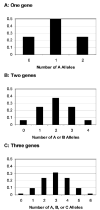Analysis of genetically complex epilepsies
- PMID: 16359464
- PMCID: PMC1352332
- DOI: 10.1111/j.1528-1167.2005.00350.x
Analysis of genetically complex epilepsies
Abstract
During the last decade, great progress has been made in the discovery of genes that influence risk for epilepsy. However, these gene discoveries have been in epilepsies with Mendelian modes of inheritance, which comprise only a tiny fraction of all epilepsy. Most people with epilepsy have no affected relatives, suggesting that the great majority of all epilepsies are genetically complex: multiple genes contribute to their etiology, none of which has a major effect on disease risk. Gene discovery in the genetically complex epilepsies is a formidable task. It is unclear which epilepsy phenotypes are most advantageous to study, and chromosomal localization and mutation detection are much more difficult than in Mendelian epilepsies. Association studies are very promising for the identification of complex epilepsy genes, but we are still in the earliest stages of their application in the epilepsies. Future studies should employ very large sample sizes to ensure adequate statistical power, clinical phenotyping methods of the highest quality, designs and analytic techniques that control for population stratification, and state-of-the-art molecular methods. Collaborative studies are essential to achieve these goals.
Figures



References
-
- Risch NJ. Searching for genetic determinants in the new millennium. Nature. 2000;405:847–56. - PubMed
-
- Risch N, Merikangas K. The future of genetic studies of complex human diseases. Science. 1996;273:1516–7. - PubMed
-
- Fisher RA. The correlation between relatives under the supposition of mendelian inheritance. Trans R Soc Edin. 1918;52:399–433.
-
- Falconer DS. The inheritance of liability to certain diseases estimated from the incidence among relatives. Ann Hum Genet. 1965;29:51–76.
-
- Ottman R. Simple test of the Multifactorial-Polygenic Model with sex dependent thresholds. J Chronic Dis. 1987;40:165–70. - PubMed

